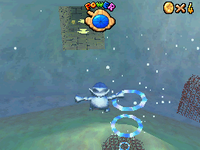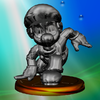|
|
| Line 48: |
Line 48: |
|
| |
|
| ===''Dr. Mario 64''=== | | ===''Dr. Mario 64''=== |
| [[File:DrMario64FinalCast.png|thumb|left|Metal Mario in the character select screen from ''Dr. Mario 64'']]
| |
| At the end of [[Wario]]'s story in ''[[Dr. Mario 64]]'' (after winning every match without losing once), [[Dr. Mario]] accidentally eats some [[Megavitamin]]s and takes on a Metal form. This metallic Dr. Mario faces off against Wario in a final battle. Once he is beaten, he can be used in multiplayer as a [[Metal Mario (character)|separate playable character]]. In VS mode, Metal Mario has the highest AI level available tying with [[Vampire Wario]]. | | At the end of [[Wario]]'s story in ''[[Dr. Mario 64]]'' (after winning every match without losing once), [[Dr. Mario]] accidentally eats some [[Megavitamin]]s and takes on a Metal form. This metallic Dr. Mario faces off against Wario in a final battle. Once he is beaten, he can be used in multiplayer as a [[Metal Mario (character)|separate playable character]]. In VS mode, Metal Mario has the highest AI level available tying with [[Vampire Wario]]. |
|
| |
|
| ===''Super Smash Bros.'' series=== | | ===''Super Smash Bros.'' series=== |
| ====''Super Smash Bros.''==== | | ====''Super Smash Bros.''==== |
| [[File:SSBIconMetal.png|frame|right|16px]]
| | [[File:Metalmario.png|thumb|100px|left|Metal Mario in ''Super Smash Bros.'']] |
| [[File:Metalmario.png|thumb|left|100px|Metal Mario in ''Super Smash Bros.'']] | |
| | |
| ===''Super Smash Bros.'' series===
| |
| [[File:Metal Bowser - Bowser - SSBWiiU.jpg|thumb|right|[[Bowser]] under the effects of the Metal Box.]]
| |
| | |
| In ''[[Super Smash Bros.]]'', Metal Mario makes his debut as a mid-boss encountered in Stage 9 out of 10 stages. He has his [[Meta Crystal|own stage]], which is playable only in the one player mode of the game. Unlike the power-up he is based on from ''[[Super Mario 64]]'', other characters can attack and rack up damage on him. To mirror his role in ''Super Mario 64'', he is a far more durable character than the regular Mario; in fact he is the heaviest and most resistant character in the game. When his damage percent is low, weaker attacks cannot flinch him, and attacks start flinching him only at far higher percentages. Due to his high weight, however, he has trouble recovering when he is knocked off the stage. Additionally, Metal Mario does not dash; he mostly walks around, patrolling the stage.
| |
| | |
| On a side note, [[Kirby]] is unable to copy Metal Mario's powers, which is later possible to do in ''Super Smash Bros. Melee''.
| |
| | |
| A [[Metal Mario (character)|Metal Mario character]] appears in the original ''[[Super Smash Bros.]]'' as a boss. The sequel, ''[[Super Smash Bros. Melee]]'', also featured this permanently metal alter-ego of Mario as well as a separate [[Metal Luigi|Luigi character]] as bosses in Adventure Mode. The trophy of Metal Mario in ''Super Smash Bros. Melee'' uses the [[Yoshi's Island (Super Smash Bros. Melee)|Yoshi's Island]] stage as its reflection.
| |
| | |
| ====''Super Smash Bros. Melee''====
| |
| {{SSB Infobox | | {{SSB Infobox |
| |name=Metal Mario | | |name=Metal Mario |
| Line 80: |
Line 67: |
| |entrance=Metal Mario pops out of a [[Warp Pipe]]. (64)<br>Metal Mario falls from the sky and lands headfirst onto the stage, then stands up afterwards. (''Melee'') | | |entrance=Metal Mario pops out of a [[Warp Pipe]]. (64)<br>Metal Mario falls from the sky and lands headfirst onto the stage, then stands up afterwards. (''Melee'') |
| }} | | }} |
| | |
| | In ''[[Super Smash Bros.]]'', Metal Mario makes his debut as a mid-boss encountered in Stage 9 out of 10 stages. He has his [[Meta Crystal|own stage]], which is playable only in the one player mode of the game. Unlike the power-up he is based on from ''[[Super Mario 64]]'', other characters can attack and rack up damage on him. To mirror his role in ''Super Mario 64'', he is a far more durable character than the regular Mario; in fact he is the heaviest and most resistant character in the game. When his damage percent is low, weaker attacks cannot flinch him, and attacks start flinching him only at far higher percentages. Due to his high weight, however, he has trouble recovering when he is knocked off the stage. Additionally, Metal Mario does not dash; he mostly walks around, patrolling the stage. |
| | |
| | On a side note, [[Kirby]] is unable to copy Metal Mario's powers, which is later possible to do in ''Super Smash Bros. Melee''. |
| | |
| | A [[Metal Mario (character)|Metal Mario character]] appears in the original ''[[Super Smash Bros.]]'' as a boss. The sequel, ''[[Super Smash Bros. Melee]]'', also featured this permanently metal alter-ego of Mario as well as a separate [[Metal Luigi|Luigi character]] as bosses in Adventure Mode. The trophy of Metal Mario in ''Super Smash Bros. Melee'' uses the [[Yoshi's Island (Super Smash Bros. Melee)|Yoshi's Island]] stage as its reflection. |
| | |
| | ====''Super Smash Bros. Melee''==== |
| Starting in ''Super Smash Bros. Melee'' and continuing in later games, players can pick up the [[Metal Box]] as an item and gain metal forms for a limited time. While metal, they are heavier (i.e. their jumping height is lower and falling speed is faster) and silent, except for clanging metal noises made when they move. The metal duration can last shorter if players take enough damage. | | Starting in ''Super Smash Bros. Melee'' and continuing in later games, players can pick up the [[Metal Box]] as an item and gain metal forms for a limited time. While metal, they are heavier (i.e. their jumping height is lower and falling speed is faster) and silent, except for clanging metal noises made when they move. The metal duration can last shorter if players take enough damage. |
|
| |
|
| Line 92: |
Line 87: |
|
| |
|
| ====''Super Smash Bros. for Nintendo 3DS/Wii U''==== | | ====''Super Smash Bros. for Nintendo 3DS/Wii U''==== |
| | [[File:Metal Bowser - Bowser - SSBWiiU.jpg|thumb|left|[[Bowser]] under the effects of the Metal Box.]] |
| Opponents in metal form, marked as intruders, can be encountered in the single player Classic Mode of ''Super Smash Bros. for Wii U''. When the player chooses a battle in the first five rounds, one or more opponents might suddenly be replaced by an intruder, marked by a glowing yellow trophy base, even in a team battle. Intruders are always in a permanent Giant or Metal state, but are guaranteed to be carrying a prize of some kind for victory. | | Opponents in metal form, marked as intruders, can be encountered in the single player Classic Mode of ''Super Smash Bros. for Wii U''. When the player chooses a battle in the first five rounds, one or more opponents might suddenly be replaced by an intruder, marked by a glowing yellow trophy base, even in a team battle. Intruders are always in a permanent Giant or Metal state, but are guaranteed to be carrying a prize of some kind for victory. |
|
| |
|
This article is under construction. Therefore, please excuse its informal appearance while it is being worked on. We hope to have it completed as soon as possible. This article is currently under construction by Bazooka Mario (talk).
Template:More images
Template:Form-infobox
Template:Quote2
Metal Mario (called Metal Power in Super Mario 64 DS[1]) is a recurring power-up of Mario as well as a playable variant of Mario that first appears in Super Mario 64. Metal Mario is tougher, stronger, and virtually invincible except for long falls. This form is acquired through various means such as by picking up the Metal Cap from green ! Blocks, using Metal Boxes, or using Metal Mushroom Orbs. Later games also feature other characters receiving the metal power-up, particularly in Mario Party 6 and the Super Smash Bros. series, though the form itself acts the same.
The form has also appeared as a separate character from Mario, such as being a late-game boss in Super Smash Bros. games, and the Metal Mario character has been playable in several kart racing and sports games. A few bios refer to this Metal Mario as Mario's rival. His voice varies in some games, sharing Mario's voice, sharing Mario's voice but with a filter, or having independent lines and with a filter. Some of his lines are altered versions of Mario's lines, such as "Mia mama" as opposed to Mario's "Mama mia" and "Papa" instead of "Mama".
History
Super Mario series
Super Mario 64
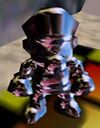
Mario wearing the Metal Cap in
Super Mario 64When Mario first encounters the Metal Cap in the Cavern of the Metal Cap in Super Mario 64, he becomes Metal Mario. In this form, Mario is invincible (although he can still take falling damage) and can destroy enemies just by running into them. Metal Mario is also very heavy, and as such, he can withstand strong winds and underwater currents and can walk on the bottom of bodies of water. In addition, he does not need to breathe, meaning he can stay underwater without worrying about air until the metal power runs out. Despite being heavy, Metal Mario still retains all his physical speed as well as his athletic jumping abilities, but he sinks in quicksand faster.
Metal Mario can combine his Metal Cap with the Vanish Cap to become Vanish Metal Mario, which will enable him to go through certain walls while maintaining his metal form's strengths and weaknesses.
The music that plays when the player is Metal Mario is an arrangement of the Starman's theme from Super Mario Bros. Metal Mario's reflection texture is actually a fisheye photo of a garden.[2]
Super Mario 64 DS
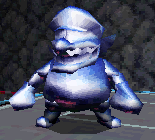
Metal Wario in
Super Mario 64 DSIn the remake of Super Mario 64 for the Nintendo DS, Super Mario 64 DS, only Wario can turn metallic and become Metal Wario by using a Power Flower. He is able to walk on lava and freezing water, though after a while, he begins to sink, and if he goes below the surface, he will lose a life, similar to with the slower quicksand. Metal Wario's other abilities and vulnerabilities are the same as Metal Mario's.
The Mega Mario and Fire Power themes from Super Mario 64 DS are arrangements of Metal Mario's theme music.
Super Mario Odyssey
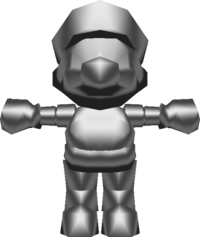
Metal Mario Outfit model from
Super Mario OdysseyIn Super Mario Odyssey, a cap and outfit based on the Metal form's Super Mario 64 appearance (named the Metal Mario Cap and the Metal Mario Suit respectively) can be purchased from Crazy Cap stores. The outfit costs 2000 coins and is available after 540 Power Moons have been collected, and the cap costs 1000 coins and is available after 560 Power Moons have been collected. Aside from allowing Mario to enter a specific area in the Mushroom Kingdom, this outfit is aesthetic and serves no other gameplay advantage. Clanking can be heard as Mario walks in the outfit, and Cappy makes an audible clink if he hits a wall when thrown. The description for the Metal Mario Suit implies that Metal Mario is specifically made out of aluminium.
Mario Golf series
Mario Golf (Nintendo 64)
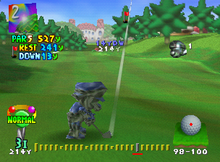
Metal Mario in
Mario GolfMetal Mario makes his playable debut as an unlockable character in Mario Golf. He is unlocked when players collect all 108 Birdie Badges. He boasts the strongest drives from his set of clubs, meaning he can hit the ball the furthest out of any character in the game, though his sweet spot and control come at a cost. Metal Mario's ball trajectory is a strong draw, meaning that the ball has a strong curve to the right. If Metal Mario scores a Nice Shot while using a power shot, the ball goes into flames, which is shared with the other Mario characters, namely Mario and Baby Mario. Metal Mario shares his voice clips as Mario. In Japanese versions of the game, Metal Mario is absent.
Mario Golf (Game Boy Color)
Although Metal Mario does not make an appearance in Mario Golf for the Game Boy Color, he is mentioned on the Score Card.
Dr. Mario 64
At the end of Wario's story in Dr. Mario 64 (after winning every match without losing once), Dr. Mario accidentally eats some Megavitamins and takes on a Metal form. This metallic Dr. Mario faces off against Wario in a final battle. Once he is beaten, he can be used in multiplayer as a separate playable character. In VS mode, Metal Mario has the highest AI level available tying with Vampire Wario.
Super Smash Bros. series
Super Smash Bros.
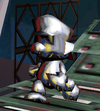
Metal Mario in
Super Smash Bros.Template:SSB Infobox
In Super Smash Bros., Metal Mario makes his debut as a mid-boss encountered in Stage 9 out of 10 stages. He has his own stage, which is playable only in the one player mode of the game. Unlike the power-up he is based on from Super Mario 64, other characters can attack and rack up damage on him. To mirror his role in Super Mario 64, he is a far more durable character than the regular Mario; in fact he is the heaviest and most resistant character in the game. When his damage percent is low, weaker attacks cannot flinch him, and attacks start flinching him only at far higher percentages. Due to his high weight, however, he has trouble recovering when he is knocked off the stage. Additionally, Metal Mario does not dash; he mostly walks around, patrolling the stage.
On a side note, Kirby is unable to copy Metal Mario's powers, which is later possible to do in Super Smash Bros. Melee.
A Metal Mario character appears in the original Super Smash Bros. as a boss. The sequel, Super Smash Bros. Melee, also featured this permanently metal alter-ego of Mario as well as a separate Luigi character as bosses in Adventure Mode. The trophy of Metal Mario in Super Smash Bros. Melee uses the Yoshi's Island stage as its reflection.
Super Smash Bros. Melee
Starting in Super Smash Bros. Melee and continuing in later games, players can pick up the Metal Box as an item and gain metal forms for a limited time. While metal, they are heavier (i.e. their jumping height is lower and falling speed is faster) and silent, except for clanging metal noises made when they move. The metal duration can last shorter if players take enough damage.
In level 10 of Classic Mode of Super Smash Bros. Melee, a random character in a permanent metal form will always be one of the selected challengers.
In Adventure Mode, the Metal Mario character returns as a mid-boss in Adventure Mode, being fought on Battlefield. Metal Mario fights alone by default, but if the player unlocks Luigi, Metal Luigi joins the fray as well. They both retain their strengths from Super Smash Bros.; Metal Mario and Metal Luigi are very heavy opponents who are tough to knock down the stage, but cannot recover once they are knocked down. Additionally, players can pick up the Metal Box item, turning into metal forms, boasting the same attributes as Metal Mario and Metal Luigi, though the power-up is not permanent, unlike Metal Mario and Metal Luigi. KOing Metal Mario and Metal Luigi in Adventure Mode awards the player the "Metal Bros. KO" bonus, worth 8000 points.
Metal Mario also appears as one of the many collectible trophies in the game. Yoshi's Island, a stage in the game, is reflected on the texture of Metal Mario's model.
Super Smash Bros. Brawl
In Super Smash Bros. Brawl, the metal form can be enabled as a setting in Special Brawl of Super Smash Bros. Brawl as well as corresponding Special modes of the subsequent games, where it is permanent. In Classic Mode, a character in metal form can appear at random from Levels 6 to 10.
Super Smash Bros. for Nintendo 3DS/Wii U
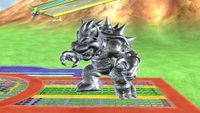
Bowser under the effects of the Metal Box.
Opponents in metal form, marked as intruders, can be encountered in the single player Classic Mode of Super Smash Bros. for Wii U. When the player chooses a battle in the first five rounds, one or more opponents might suddenly be replaced by an intruder, marked by a glowing yellow trophy base, even in a team battle. Intruders are always in a permanent Giant or Metal state, but are guaranteed to be carrying a prize of some kind for victory.
Additionally, the Metal Box is also available as a red item in Smash Tour, giving players the ability to start a battle in metal form. Crazy Orders may also feature a Metal Battle as a potential order option.
In Smash Run of Super Smash Bros. for Nintendo 3DS, alongside the Fighting Mii Team, normal-sized and giant Metal versions of the player's character may appear in the game's Multi-Man Smash Final Battle as opponents.
Super Smash Bros. Ultimate
In Super Smash Bros. Ultimate, Metal Mario appears as the final boss in Bowser's classic mode route, appearing after Mario is defeated in a similar manner to Giga Bowser in Mario's route and in Super Smash Bros. Melee. He also appears as an Ace-class Shield-type primary spirit with one support slot, using his Mario Kart 7 artwork. The spirit increases a fighter's weight during battle. In the spirit's battle, the player faces a metallic Mario on the Battlefield form of The Great Cave Offensive as a reference to his battle in the original Super Smash Bros.
Metal Mario's core can be combined with the cores of a Super Mushroom and a Fire Flower to summon the Gold Mario spirit.
Mario Party series
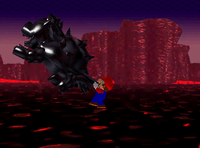
Mario swinging Metal Bowser.
Metal Bowser appears in Mario Party 2 after playing a game on Bowser Land, where the winner heads to fight Bowser but when the character grabs his tail, he transforms into Metal Bowser, making him impossible to lift. To deal with this, Toad offers a Power Star to give more power to the winner and thus, Metal Bowser is swung and thrown around the world. Crash-landing, Bowser's metal form is shattered to pieces, reverting him to his normal form.
The metal form also appears in Mario Party 6 and Mario Party 7 when one of the playable characters uses a Metal Mushroom Orb on themselves to avoid traps. Also, when a player gets a Cursed Mushroom Panel, Bowser makes a brief reference to Metal Mario, by saying, "Answer quickly or your bonus points will fall like a Metal Mario off an airship!"
Puzzle & Dragons: Super Mario Bros. Edition
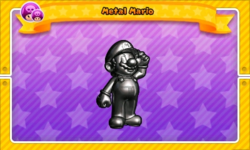
Metal Mario as he appears in the Guide.
Metal Mario appears in Puzzle & Dragons: Super Mario Bros. Edition as a Leader, available with the game's digital update to version 2.0, unlocked after earning an S rank or higher in Course 3 of the Fixed Challenges in Score Attack. Metal Mario is a Dark/Dark attribute teammate with an HP rating of 4/6, an ATK rating of 5/6 and RCV rating of 2/6. Metal Mario's Skill, Metal Walk, changes Water Orbs on the Orb field to Dark Orbs, while his Leader Skill, Metal Shine, raises the ATK of the entire team by 3x if the player clears two Dark combos, or by 4x for three Dark combos or more. Metal Mario uses Fruit and Rare Fruit to raise his Skill Levels.
Metal Luigi also appears as a Leader, unlocked after earning an S rank or higher in Course 3 of the Free Challenges in Score Attack. Metal Luigi is also a Dark/Dark attribute teammate, having an HP rating of 3/6, an ATK rating of 5/6 and RCV rating of 3/6. Metal Luigi's Skill, Metal Dash, changes Light Orbs on the Orb field to Dark Orbs. Metal Luigi shares the same Leader Skill and Skill Up requirements as Metal Mario.
Game appearances
Profiles
Super Smash Bros. Melee trophy
| #
|
Name
|
Image
|
Appearance(s)
|
Description
|
| 202
|
Metal Mario
|
|
Super Mario 64
9/96
|
Mario was in for a surprise the first time he hit a Metal Box in Super Mario 64. The metal cap that popped out transformed Mario into living metal, giving him great stamina, a heavy tread, and the ability to walk underwater. In Super Smash Bros., Metal Mario showed up as an incredibly stubborn midlevel boss.
|
Gallery
Metal Mario in Super Mario 64.
Metal Mario using the Vanish Cap in Super Mario 64.
Puzzle & Dragons: Super Mario Bros. Edition
Puzzle & Dragons: Super Mario Bros. Edition
Puzzle & Dragons: Super Mario Bros. Edition
Puzzle & Dragons: Super Mario Bros. Edition
Puzzle & Dragons: Super Mario Bros. Edition
The "Super Mario Power Up" series of keychains from Nintendo TOKYO
Media
- Help:Media • Having trouble playing?
See also
Names in other languages
| Language
|
Name
|
Meaning
|
Notes
|
| Japanese
|
メタルマリオ[?]
Metaru Mario
|
Metal Mario
|
|
| Chinese (traditional)
|
金屬瑪利歐[3]
Jīnshǔ Mǎlì'ōu
|
Metal Mario
|
|
| Dutch
|
Metalen Mario[?]
|
Metal Mario
|
|
| French
|
Mario de métal
Métal Mario (Mario Kart 7 / Super Mario 3D All-Stars)[4]
|
Metal Mario
|
|
| German
|
Metall-Mario[?]
|
Metal Mario
|
|
| Italian
|
Mario metallo[?]
|
Metal Mario
|
|
| Korean
|
메탈마리오[?]
Metal Mario
|
Metal Mario
|
|
| Portuguese (NOA)
|
Mario metálico[?]
|
Metallic Mario
|
|
| Russian
|
Марио-металл[?]
Mario-metall
|
Metal Mario
|
|
| Spanish (NOA)
|
Mario de metal[?]
|
Metal Mario
|
|
| Spanish (NOE)
|
Mario de Metal[?]
|
Metal Mario
|
|
Trivia
- In an interview with Shigeru Miyamoto in Nintendo Power's Mario Mania Player's Guide published in 1991, Miyamoto reportedly said: "Who knows what Mario will look like in the future? Maybe he'll wear metallic clothes!"[5] Coincidentally, the Metal Mario form's first appearance was in 1996, five years later.
- Three years after Shigeru Miyamoto's interview, the earliest visual depiction of a metallic Mario occurred through a Super Game Boy commercial, which also predates Metal Mario's appearance two years later.[6]
- The Silver Mario and Gold Mario costumes from Super Mario Maker play the Metallic Mario music when a Super Star is collected.
References
- ^ Super Mario 64 DS instruction booket. Page 21.
- ^ Kid Leaves Stoop (March 19, 2021). The most overused game graphic you never noticed | Texture Archaeology. YouTube. Retrieved July 26, 2012.
- ^ Nintendo Switch 佳節禮物遊戲大合集. Page 5. nintendo.com. Retrieved February 3, 2021.
- ^ Super Mario™ 3D All-Stars pour la console Nintendo Switch™. nintendo.com. Archived January 16, 2021, 20:20:58 UTC from the original via Wayback Machine. Retrieved November 10, 2021.
- ^ VGArtAndTidbits (October 11, 2018). Shigeru Miyamoto interview from the 1991 book “Mario Mania” - the official Super Mario World strategy guide. Also included is isolated and cleaned art of Yoshi’s concept sketch from the upper left corner of the third page. Twitter. Retrieved September 18, 2020.
- ^ Japancommercials4U2 (December 29, 2009). Super Game Boy JPN Commercial. YouTube. Retrieved September 19, 2020.
Template:Mario's Transformations
Template:MG64
| Mario Kart Tour
|
| Drivers
|
| Normal
|
Baby Mario • Baby Peach • Baby Daisy • Baby Rosalina • Baby Luigi • Koopa Troopa • Shy Guy • Dry Bones • Iggy • Larry • Lemmy • Ludwig • Morton • Roy • Wendy
|
| Super
|
Mario • Peach • Yoshi • Daisy • Toad • Toadette • Rosalina • Luigi • Toad (Pit Crew) • Red Yoshi • Blue Yoshi • Pink Yoshi • Yellow Toad (Pit Crew) • Light-blue Toad (Pit Crew) • Red Toad (Pit Crew) • Orange Yoshi • Green Toad (Pit Crew) • Pink Toad (Pit Crew) • Light-blue Yoshi • Yellow Yoshi • Purple Toad (Pit Crew) • Bowser • Donkey Kong • Diddy Kong • Lakitu • Bowser Jr. • Wario • Waluigi • King Boo • Black Shy Guy • Red Koopa (Freerunning) • Birdo • Pink Shy Guy • Birdo (Light Blue) • Hammer Bro • Boomerang Bro • Ice Bro • Fire Bro • Birdo (Yellow) • Monty Mole • Green Shy Guy • Blue Koopa (Freerunning) • Birdo (Blue) • Purple Koopa (Freerunning) • Light-blue Shy Guy • Blue Shy Guy • Birdo (Orange) • White Shy Guy • Koopa (Freerunning) • Orange Shy Guy • Birdo (Red) • Yellow Shy Guy • Birdo (Green)
|
| High-End
|
Metal Mario • Peachette • Pauline • Mario (Musician) • Peach (Kimono) • Mario (Hakama) • Rosalina (Halloween) • Peach (Vacation) • Mario (Santa) • Pink Gold Peach • Daisy (Holiday Cheer) • Yoshi (Reindeer) • Pauline (Party Time) • Mario (Happi) • Toad (Party Time) • Peach (Wintertime) • Penguin Luigi • Ice Mario • Baby Peach (Cherub) • Rosalina (Aurora) • Mario (Classic) • Luigi (Classic) • Baby Rosalina (Detective) • Yoshi (Egg Hunt) • Black Yoshi • Builder Mario • Builder Toad • Daisy (Fairy) • Mario (Chef) • Peach (Wedding) • Rosalina (Swimwear) • Mario (Swimwear) • Captain Toad • Toadette (Explorer) • Daisy (Yukata) • Mario (SNES) • Mario (Sunshine) • Mario (Halloween) • Peach (Halloween) • Peach (Explorer) • Builder Luigi • Fire Rosalina • Luigi (Lederhosen) • Cat Peach • Cat Toad • Pauline (Rose) • Penguin Toad • Mario (Racing) • White Yoshi • Baby Mario (Koala) • Builder Toadette • Mario (Tuxedo) • Luigi (Painter) • Daisy (Swimwear) • Mario (Baseball) • Peach (Happi) • Penguin Mario • Yoshi (Kangaroo) • Tanooki Mario • Tanooki Rosalina • Mario (Satellaview) • Penguin Toadette • Cat Rosalina • Luigi (Vacation) • Mario (Golf) • Luigi (Golf) • Mario (Aviator) • Mario (Samurai) • Peach (Yukata) • Yoshi (Gold Egg) • Rosalina (Volendam) • Daisy (Farmer) • Dr. Mario • Dr. Luigi • Dr. Peach • Cat Mario • Cat Luigi • Rosalina (Chef) • Daisy (Thai Dress) • Daisy (Sailor) • Toadette (Sailor) • White Tanooki Mario • Luigi (Knight) • Mario (King) • Luigi (Chef) • Kitsune Luigi • Toad (Astronaut) • Toadette (Astronaut) • Poochy • Toad (Tourist) • Luigi (Gold Knight) • Pauline (Cowgirl) • Mario (Black Suit) • Gold Mario • Dry Bowser • King Boo (Luigi's Mansion) • Shy Guy (Pastry Chef) • Waluigi (Bus Driver) • Gold Koopa (Freerunning) • Wario (Hiker) • Dry Bones (Gold) • Funky Kong • Dixie Kong • Dry Bowser (Gold) • Wario (Cowboy) • Nabbit • Bowser Jr. (Pirate) • King Bob-omb • Donkey Kong Jr. (SNES) • Shy Guy (Gold) • King Boo (Gold) • Bowser (Santa) • Lakitu (Party Time) • Birdo (Black) • Shy Guy (Ninja) • King Bob-omb (Gold) • Kamek • Waluigi (Vampire) • Meowser • Chargin' Chuck • Pink Shy Guy (Ninja) • Birdo (White) • Dr. Bowser • Petey Piranha • Chargin' Chuck (Gold) • Petey Piranha (Gold) • Larry (Wintertime) • Light-blue Shy Guy (Explorer) • Yellow Shy Guy (Explorer) • Donkey Kong (Gladiator) • Wiggler • Wiggler (Gold) • Mii Racing Suits
|
| Vehicle parts
|
| Karts |
Normal
|
Pipe Frame • Birthday Girl • Mushmellow • Koopa Dasher • Biddybuggy • Blue Biddybuggy • Cheep Charger • Pink Mushmellow • Birthday Girl Rosalina • Green Kiddie Kart • Red Kiddie Kart • Bullet Blaster • Bull's-Eye Banzai • Landship • Pipe Buggy • Warship • Green Cheep Charger
|
| Super
|
Mach 8 • Daytripper • Turbo Yoshi • Soda Jet • Super Blooper • Gold Blooper • Royale • Cloud 9 • Poltergust 4000 • Streamliner • White Royale • Zucchini • Red Streamliner • Red Turbo Yoshi • Blue Seven • Super 1 • Dasher II • Tea Coupe • Yellow Turbo Birdo • Egg 1 • Birthday Girl Daisy • Red Standard 8 • Green Standard 8 • Cucumber • Blue Royale • Blue Turbo Yoshi • Orange Turbo Yoshi • Pink Turbo Yoshi • Light-blue Turbo Yoshi • Yellow Turbo Yoshi • Flame Flyer • Barrel Train • DK Jumbo • Chrome DK Jumbo • Koopa Clown • Dark Clown • Para-Wing • Turbo Birdo • Light-blue Turbo Birdo • Bolt Buggy • Rambi Rider • Blue Turbo Birdo • Orange Turbo Birdo • Red Turbo Birdo • Green Turbo Birdo
|
| High-End
|
B Dasher • Black B Dasher • Yellow Taxi • Quickshaw • Kabuki Dasher • Circuit Special • Black Circuit • Bumble V • Queen Bee • Trickster • Ghost Ride • Macharon • Carrot Kart • Cheermellow • Wild Wing • Radish Rider • Wildfire Flyer • Ribbon Rider • Double-Decker • Swift Jack • Red B Dasher • Jingle Bells • Platinum Taxi • Glam Bruiser • Gilded Prancer • Ice-blue Poltergust • P-Wing • Apple Kart • Comet Tail • Bright Bunny • Dozer Dasher • Clanky Kart • Wild Black • Karp Kart • Prancer • Rose Queen • Green Apple Kart • Choco Macharon • Gold Egg • Sweet Daytripper • Red Taxi • Pink Wing • Happy Ride • Blue Soda • Clackety Kart • Gold Clanky Kart • Festival Girl • Black Kabuki Dasher • 8-Bit Pipe Frame • Gold Pipe Frame • Surf Sailer • Star-Spangled Flyer • Green Circuit • Sports Coupe • Pumpkin Kart • Dark Trickster • Sunset Cloud • Steel Driver • Holiday King • Gold Snow Skimmer • Dreamy Egg • Fast Frank • Iron Cucumber • Cat Cruiser • Wild Pink • Rose Taxi • B Dasher Mk. 2 • Decal Streamliner • Orange Streamliner • White Turbo Yoshi • Sakura Quickshaw • Jet Cruiser • Inferno Flyer • Rambi Runner • Pink Dozer • Grand Badwagon • Paintster • Lime Tea Coupe • Sunny Surf Sailer • Pinch Hitter • Cleanup Hitter • Ice Dozer • Green Double-Decker • Black Cat Cruiser • Red B Dasher Mk. 2 • Pink B Dasher Mk. 2 • Classic B Dasher Mk. 2 • Sky-Blue B Dasher Mk. 2 • Metal B Dasher Mk. 2 • Cream B Dasher Mk. 2 • Green B Dasher Mk. 2 • Tanooki Kart • Gold Pumpkin Kart • Lunar Cruiser • Sleigh Rider • White Snow Skimmer • Frosty Bells • Frost Wing • Gray Cat Cruiser • Sports Coupe 2022 • Roaring Racer • Jukebox Buggy • Sneeker • Green Lightning • Cupid's Arrow • Wild Slugger • Prop Kart • Magma Broom • Star Broom • Yellow 8-Bit Pipe Frame • Warrior Wagon • Armored Rider • Black Turbo Yoshi • Gold Bunny • Flower Kart • Dragonfly • Firefly • Daikon Rocket • Capsule Kart • Blue-Green Capsule Kart • White Bruiser • Coconut 1 • Pink Capsule Kart • Cream Cat Cruiser • Green Cat Cruiser • Goo-Goo Buggy • Goo-Goo Pink • Gold Kiddie Kart • Sweet Ride • White Fast Frank • Tuk-Tuk Kart • Tropical Truck • Gold Zucchini • Lightning Streamliner • Flowery Badwagon • Coral Jet Cruiser • Watermelon Kart • Ice-Cream Minibus • Chocolate Banana Minibus • Strawberry Soft Swerve • Shielded Speedster • Gold Standard • Gold Double-Decker • Black Carriage • Green Speeder • Flaming Speeder • Gold Sweet Ride • Streetle • Blue Speeder • Swift Talon • Gold Eagle • Blazing Eagle • Camo Tanooki Kart • Gold Rambi Rider • Moo Moo Offroader • Pink Speeder • Pink Sneeker • Gold Jingle Bell • Holiday Speeder • Wild Gold • Rainbow Taxi • Blooper Shuttle • Gold Lunar Cruiser • Gold Quickshaw • Pineapple 1 • Hot Pot Hot Rod • Rainbow Streetle • Gold Capsule Kart • Gold 8-Bit Pipe Frame • Taiko Drum Dasher • Sakura Sports Coupe • Bright Girl • Huffin Puffin Egg • Jumbo Jetter • Gold Paintster • Silver Flower Kart • Bronze Cucumber • Cream Classic • Red Comet • Pink Comet • Green Comet • Gold Comet • Mach 8-R • Gold Cupid's Arrow • Silver Cupid's Arrow • Silver Warrior Wagon • Gold Warrior Wagon • Black Shielded Speedster • Gold Shielded Speedster • Yeehaw Wagon • Desert Rose Wagon • Yellow Sub Scooter • Blue Sub Scooter • Gold Driver • Dolphin Drifter • Purple Rattle Buggy • Goo-Goo Gold • Gold Wild Slugger • Spicy Zucchini • Chocolate Mint Soft Swerve • Gold Soft Swerve • Monarch Kart • Gold Monarch Kart • Black B Dasher Mk. 2 • Gold B Dasher • Badwagon • Blue Badwagon • Gold Train • Bruiser • Snow Skimmer • Offroader • Banana Master • Poison Apple Kart • Cheep Snorkel • Gold Cheep Snorkel • Gold Cheep Charger • Dark Buggy • Koopa King • Brown Offroader • Cact-X • Pirate Sushi Racer • Silver Bullet Blaster • Head Honcho • DK Maximum • Sushi Racer • Gilded King • Crawly Kart • Black Dozer • Party-Wing • Penguin Slider • Black Penguin Slider • Cact-Ice • Black Turbo Birdo • Purple Bunny • Jade Hop Rod • Crimson Hop Rod • Dark Hop Rod • Kamek's Zoom Broom • Silver King • Vampire Flyer • Red Crawly Kart • Yellow Offroader • Cact-R • Cheership • Candy Clown • Tiger Bruiser • Combo Cruiser • Sakura Hop Rod • White Turbo Birdo • Green-Yellow Capsule Kart • Piranha Pipes • Red Offroader • Goo-Goo Black • Cact-B • Gold Bullet Blaster • Red Vampire Flyer • Gold Trickster • Gold Bruiser • Black Sneeker • Purple Dozer • Blue Crawly Kart • Rainbow Pipe Buggy • Gold Hop Rod • Black Jingle Bell • Gold Sushi Racer • Dry Bones Dasher • Waluigi Racer Mk. 2 • Chain Chomp Chariot • Fish Bone Ferry • Gold Fish Bone Ferry • Wiggler Egg • Boo Pipes • Gold Pipes • Wild Wiggler
|
| Gliders |
Normal
|
Super Glider • Parachute • Parafoil • Paper Glider • Droplet Glider • BBIA Parafoil • Minion Paper Glider • Piston Glider • Piranha Plant Parafoil
|
| Super
|
Peach Parasol • Flower Glider • Oilpaper Umbrella • Lightning Oilpaper • Pink Flower Glider • 8-Bit Jumping Mario • ? Block • Plaid Ribbon • Eggshell Glider • 8-Bit Jumping Luigi • Mushroom Glider • Bob-omb Parafoil • Shell Parachute • Wario Wing • Waluigi Wing • BaNaNa Parafoil • Blue Flower Glider
|
| High-End
|
Gold Glider • Fare Flier • Purple Oilpaper Umbrella • Full Flight • Strawberry Crêpe • Le Tricolore • Starchute • Royal Parachute • Glitter Glider • Soaring Jack • Gift Glider • New Year's 2020 • New Year's Kite • Fireworks Parachute • Crimson Crane • Blizzard Parasol • Blizzard Balloons • Sweetheart Glider • Heart Balloons • Luma Parafoil • Rainbow Starchute • Bright Glider • Safety Glider • Daisy Glider • Pink Gold Paper Glider • Butterfly Sunset • Chocolate Donut • Gold Crane • Chocolate Banana Crêpe • Strawberry Donut • Silver Bells • Silver-and-Gold Hearts • Manta Glider • Treasure Map • Butterfly Wings • Great Sail • Festival Wings • 8-Bit Star • Super Mario Kart Glider • Star-Spangled Glider • Spider Glider • Sunset Balloons • Silver Starchute • Jolly Bells • Butterfly Prism • Planet Glider • New Year's 2021 • Gold New Year's Kite • Toe-Bean Balloons • Calico Parafoil • Black Great Sail • Silver Manta Glider • Rose Parasol • Snow Crystals • 8-Bit Fire Flower • Surf Master • Starry Great Sail • Black Toe-Bean Balloons • 8-Bit Bullet Bill • Glinting Glider • Flying Easel • Sunny Surf Master • Polka-Dot Manta Glider • Home-Field Glider • Gold Home-Field Glider • Springtime Crane • Yukata Ribbon • Silver Surf Master • Ship's Wheel • Tanooki Parafoil • Gold Tanooki Parafoil • Magic Parasol • 8-Bit Super Mushroom • Meteor Balloons • Pink Gold Meteors • Galaxy Glider • Candlelight Flight • Gold Penguin Wingtip • Aurora Balloons • New Year's 2022 • Black Cat Parafoil • Cat Parafoil • Gold Toe-Bean Balloons • Glittering Parasol • Luigi Parafoil • Sky-High Flyer • Record Setter • Mario's Mustache • Luigi's Mustache • Origami Glider • Sakura Origami Glider • Gold Eggshell Glider • Green Sprout • Magniflying Glass • Flybrary Book • Pink Magniflying Glass • Cream Toe-Bean Balloons • Green Cat Parafoil • Candlelight Flight Cake • Pretzel Glider • Tulip Corsage • Red and Gold Umbrella • 8-Bit 1-Up Mushroom • Tropical Balloons • Fire Manta Glider • Mint & Berry Balloons • Vanilla & Chocolate Balloons • Icy Mario's Mustache • Flying Flappers • Silver Luigi's Mustache • Mario's Hat Balloon • Luigi's Hat Balloon • Gold Cloud Balloons • White Waves Origami Glider • Chocolate Pretzel • Para-Panini • Silver Candlelight Flight • Autumn Leaves • Calico Toe-Bean Balloons • Wonderful Garnet • Festive Holly • Yellow Hard Hat Balloon • Fuzzy Kite • Gold Hard Hat Balloon • New Year's 2023 • Gold Meteors • Rainbow Fare Flier • Stealth Glider • Gold Umbrella • Wonderful Diamond • Gold Candlelight Flight • 8-Bit Super Glider • Gold 8-Bit Glider • 8-Bit Block Glider • 8-Bit Goomba • Bright Ribbon • Yoshi's Cookies • Smiley Flower Glider • Golden Glider • Gold Tulips • Gold Manta Glider • Red Checkered Glider • Pink Checkered Glider • Green Checkered Glider • Gold Checkered Glider • Gold Origami Glider • Gold Bells • Glittering Glider • Red Emblem • Green Emblem • Mario Bros. Parafoil • Mosaic Starchute • Jellychute • Wavy Great Sail • Dolphin Great Sail • Pink Bubble Balloon • Mario Golf Cap • Luigi Golf Cap • Gold Mario Golf Cap • Melon & Banana Balloons • Spooky Sprinkle Balloons • Gold Chocolate Balloons • Royal Flush • Rainbow Bells • Gold Mario's Hat Balloon • Swooper • Bullet Bill Parachute • Cloud Glider • Rainy Balloons • Wicked Wings • Gold Swooper • Banana Wingtip • Tropical Glider • Dragon Wings • Blooper Wingtip • Nabbit Oilpaper Umbrella • Cheep Cheep Masks • Dry Bowser Umbrella • Penguin Wingtip • Bright Balloons • Ninja Scroll • Dream Glider • Vampire Wings • Golden Wings • Wario's Mustache • Waluigi's Mustache • Wonderful Wings • Wicked Topaz • Piranha Plant Balloons • Secret Scroll • Lava Rocks • Black Starchute • Boo Masks • Nabbit Parachute • Gold Boo Masks • Roy Oilpaper • Rainbow Flappy Wings • Gold Flappy Wings • Wiggler Parachute • Gold Piranha Plant Balloons • Baby Mario Hanafuda • Yoshi's Egg Hanafuda • Peach Hanafuda • Barrel Hanafuda • Blooper Hanafuda • Cape Mario Hanafuda • Bullet Bill Hanafuda • Boo Hanafuda • Piranha Plant Hanafuda • Goomba Hanafuda • Jumping Mario Hanafuda • Bowser Hanafuda
|
| Tires
|
Blue Standard • Cyber Slick • Gold Tires • Metal • Monster • Mushroom • Off-Road • Red Monster • Retro Off-Road • Roller • Slick • Slim • Sponge • Standard • Wood
|
| Courses
|
| New courses |
City courses
|
New York Minute (R, T, R/T, 2, 2R, 2T, 2R/T, 3, 3R, 3T, 3R/T, 4, 4R, 4T, 4R/T) (tour appearances) • Tokyo Blur (R, T, R/T, 2, 2R, 2T, 2R/T, 3, 3R, 3T, 3R/T, 4, 4R, 4T, 4R/T) (tour appearances) • Paris Promenade (R, T, R/T, 2, 2R, 2T, 2R/T, 3, 3R, 3T, 3R/T) (tour appearances) • London Loop (R, T, R/T, 2, 2R, 2T, 2R/T, 3, 3R, 3T, 3R/T) (tour appearances) • Vancouver Velocity (R, T, R/T, 2, 2R, 2T, 2R/T, 3, 3R, 3T, 3R/T) (tour appearances) • Los Angeles Laps (R, T, R/T, 2, 2R, 2T, 2R/T, 3, 3R, 3T, 3R/T) (tour appearances) • Berlin Byways (R, T, R/T, 2, 2R, 2T, 2R/T, 3, 3R, 3T, 3R/T) (tour appearances) • Sydney Sprint (R, T, R/T, 2, 2R, 2T, 2R/T, 3, 3R, 3T, 3R/T) (tour appearances) • Singapore Speedway (R, T, R/T, 2, 2R, 2T, 2R/T, 3, 3R, 3T, 3R/T) (tour appearances) • Amsterdam Drift (R, T, R/T, 2, 2R, 2T, 2R/T, 3, 3R, 3T, 3R/T) (tour appearances) • Bangkok Rush (R, T, R/T, 2, 2R, 2T, 2R/T, 3, 3R, 3T, 3R/T) (tour appearances) • Athens Dash (R, T, R/T, 2, 2R, 2T, 2R/T, 3, 3R, 3T, 3R/T) (tour appearances) • Rome Avanti (R, T, R/T, 2, 2R, 2T, 2R/T, 3, 3R, 3T, 3R/T) (tour appearances) • Madrid Drive (R, T, R/T, 2, 2R, 2T, 2R/T, 3, 3R, 3T, 3R/T) (tour appearances)
|
| Other
|
Merry Mountain (R, T, R/T) (tour appearances) • Ninja Hideaway (R, T, R/T) (tour appearances) • Sky-High Sundae (R, T, R/T) (tour appearances) • Piranha Plant Cove (R, T, R/T, 2, 2R, 2T, 2R/T, 3, 3R, 3T, 3R/T) (tour appearances) • Yoshi's Island (R, T, R/T) (tour appearances) • Piranha Plant Pipeline (R, T, R/T) (tour appearances) • Squeaky Clean Sprint (R, T, R/T) (tour appearances)
|
| Remix courses
|
RMX Mario Circuit 1 (R, T, R/T) (tour appearances) • RMX Choco Island 1 (R, T, R/T) (tour appearances) • RMX Rainbow Road 1 (R, T, R/T) (tour appearances) • RMX Rainbow Road 2 (R, T, R/T) (tour appearances) • RMX Choco Island 2 (R, T, R/T) (tour appearances) • RMX Vanilla Lake 1 (R, T, R/T) (tour appearances) • RMX Ghost Valley 1 (R, T, R/T) (tour appearances) • RMX Bowser's Castle 1 (R, T, R/T) (tour appearances) • RMX Donut Plains 1 (R, T, R/T) (tour appearances) • RMX Vanilla Lake 2 (R, T, R/T) (tour appearances)
|
| Classic courses |
SNES courses
|
Mario Circuit 1 (R, T, R/T) (tour appearances) • Donut Plains 1 (R, T, R/T) (tour appearances) • Ghost Valley 1 (R, T, R/T) (tour appearances) • Mario Circuit 2 (R, T, R/T) (tour appearances) • Choco Island 1 (R, T, R/T) (tour appearances) • Ghost Valley 2 (R, T, R/T) (tour appearances) • Donut Plains 2 (R, T, R/T) (tour appearances) • Mario Circuit 3 (R, T, R/T) (tour appearances) • Choco Island 2 (R, T, R/T) (tour appearances) • Vanilla Lake 1 (R, T, R/T) (tour appearances) • Bowser Castle 3 (R, T, R/T) (tour appearances) • Donut Plains 3 (R, T, R/T) (tour appearances) • Koopa Troopa Beach 2 (R, T, R/T) (tour appearances) • Vanilla Lake 2 (R, T, R/T) • (tour appearances) • Rainbow Road (R, T, R/T) (tour appearances)
|
| N64 courses
|
Luigi Raceway (R, T, R/T) (tour appearances) • Koopa Troopa Beach (R, T, R/T) (tour appearances) • Kalimari Desert (R, T, R/T, 2, 2R, 2T, 2R/T) (tour appearances) • Frappe Snowland (R, T, R/T) (tour appearances) • Choco Mountain (R, T, R/T) (tour appearances) • Mario Raceway (R, T, R/T) (tour appearances) • Royal Raceway (R, T, R/T) (tour appearances) • Yoshi Valley (R, T, R/T) (tour appearances)
|
| GBA courses
|
Peach Circuit (R, T, R/T) (tour appearances) • Riverside Park (R, T, R/T) (tour appearances) • Bowser's Castle 1 (R, T, R/T) (tour appearances) • Boo Lake (R, T, R/T) (tour appearances) • Bowser's Castle 2 (R, T, R/T) (tour appearances) • Luigi Circuit (R, T, R/T) (tour appearances) • Sky Garden (R, T, R/T) (tour appearances) • Cheep-Cheep Island (R, T, R/T) (tour appearances) • Sunset Wilds (R, T, R/T) (tour appearances) • Snow Land (R, T, R/T) (tour appearances) • Yoshi Desert (R, T, R/T) (tour appearances) • Bowser's Castle 3 (R, T, R/T) (tour appearances) • Lakeside Park (R, T, R/T) (tour appearances) • Bowser's Castle 4 (R) (tour appearances)
|
| GCN courses
|
Baby Park (R, T, R/T) (tour appearances) • Mushroom Bridge (R, T, R/T) (tour appearances) • Daisy Cruiser (R, T, R/T) (tour appearances) • Waluigi Stadium (R, T, R/T) (tour appearances) • Yoshi Circuit (R, T, R/T) (tour appearances) • DK Mountain (R, T, R/T) (tour appearances) • Dino Dino Jungle (R, T, R/T) (tour appearances)
|
| DS courses
|
Luigi's Mansion (R, T, R/T) (tour appearances) • Waluigi Pinball (R, T, R/T) (tour appearances) • Shroom Ridge (R, T, R/T) (tour appearances) • DK Pass (R, T, R/T) (tour appearances) • Mario Circuit (R, T, R/T) (tour appearances) • Airship Fortress (R, T, R/T) (tour appearances) • Peach Gardens (R, T, R/T) (tour appearances)
|
| Wii courses
|
Mushroom Gorge (R, T, R/T) (tour appearances) • Coconut Mall (R, T, R/T) (tour appearances) • DK Summit (R, T, R/T) (tour appearances) • Daisy Circuit (R, T, R/T) (tour appearances) • Koopa Cape (R, T, R/T) (tour appearances) • Maple Treeway (R, T, R/T) (tour appearances) • Dry Dry Ruins (R, T, R/T) (tour appearances) • Moonview Highway (R, T, R/T) (tour appearances) • Rainbow Road (R, T, R/T) (tour appearances)
|
| 3DS courses
|
Toad Circuit (R, T, R/T) (tour appearances) • Daisy Hills (R, T, R/T) (tour appearances) • Cheep Cheep Lagoon (R, T, R/T) (tour appearances) • Shy Guy Bazaar (R, T, R/T) (tour appearances) • Mario Circuit (R, T, R/T) (tour appearances) • Rock Rock Mountain (R, T) (tour appearances) • Piranha Plant Slide (R, T, R/T) (tour appearances) • Wario Shipyard (R, T, R/T) (tour appearances) • Neo Bowser City (R, T, R/T) (tour appearances) • Rosalina's Ice World (R, T, R/T) (tour appearances) • Bowser's Castle (R, T, R/T) (tour appearances) • Rainbow Road (R, T, R/T) (tour appearances)
|
| Battle courses |
New courses
|
New York Minute B (tour appearances) • Paris Promenade B (tour appearances)
|
| Classic courses
|
GBA Battle Course 1 (tour appearances) • GCN Cookie Land (tour appearances) • DS Twilight House (tour appearances)
|
| Other
|
| Bonus challenges
|
Ready, Set, Rocket Start • Ring Race • Do Jump Boosts • Big Reverse Race • Goomba Takedown • Glider Challenge • Steer Clear of Obstacles • Vs. Mega • Smash Small Dry Bones • Break Item Boxes • Time Trial • Combo Attack • Take them out quick! • Snap a Photo • Precision Gliding • Big Reverse Race vs. 100
|
| Cups
|
Baby Daisy Cup • Baby Luigi Cup • Baby Mario Cup • Baby Peach Cup • Baby Rosalina Cup • Birdo Cup • Boomerang Bro Cup • Bowser Cup • Bowser Jr. Cup • Cat Peach Cup • Chargin' Chuck Cup • Daisy Cup • Diddy Kong Cup • Dixie Kong Cup • Donkey Kong Cup • Dry Bones Cup • Dry Bowser Cup • Fire Bro Cup • Fire Rosalina Cup • Funky Kong Cup • Gold Mario Cup • Hammer Bro Cup • Ice Bro Cup • Ice Mario Cup • Iggy Cup • Kamek Cup • King Bob-omb Cup • King Boo Cup • Koopa Troopa Cup • Lakitu Cup • Larry Cup • Lemmy Cup • Ludwig Cup • Luigi Cup • Mario Cup • Metal Mario Cup • Mii Cup • Monty Mole Cup • Morton Cup • Nabbit Cup • Pauline Cup • Peach Cup • Peachette Cup • Pink Gold Peach Cup • Poochy Cup • Rosalina Cup • Roy Cup • Shy Guy Cup • Tanooki Mario Cup • Toad Cup • Toadette Cup • Waluigi Cup • Wario Cup • Wendy Cup • Yoshi Cup
|
| Tours |
2019
|
New York Tour • Tokyo Tour • Halloween Tour • Paris Tour • Winter Tour • London Tour • Holiday Tour
|
| 2020
|
New Year's Tour • Ice Tour • Valentine's Tour • Vancouver Tour • Mario Bros. Tour • Baby Rosalina Tour • Hammer Bro Tour • Yoshi Tour • Trick Tour • Flower Tour • Jungle Tour • Cooking Tour • Peach Tour • Marine Tour • Exploration Tour • Wild West Tour • Pirate Tour • Summer Festival Tour • Super Mario Kart Tour • Los Angeles Tour • 1st Anniversary Tour • Halloween Tour • Sunset Tour • Mario vs. Luigi Tour • Winter Tour • Rosalina Tour • New Year's 2021 Tour
|
| 2021
|
Berlin Tour • Cat Tour • Peach vs. Daisy Tour • Snow Tour • Mario Tour • Yoshi Tour • Ninja Tour • Sydney Tour (April–May) • Bowser vs. DK Tour • Trick Tour • Wedding Tour • Paris Tour • Summer Tour • Los Angeles Tour • Mario vs. Peach Tour • Frost Tour • Kamek Tour • Sydney Tour (September) • 2nd Anniversary Tour • Autumn Tour • Halloween Tour • Toad vs. Toadette Tour • Space Tour • Holiday Tour • Penguin Tour • New Year's 2022 Tour
|
| 2022
|
Singapore Tour • Wario vs. Waluigi Tour • Los Angeles Tour • Sky Tour • Mii Tour • Samurai Tour • Yoshi Tour • Amsterdam Tour • Doctor Tour • Peach vs. Bowser Tour (May) • Cat Tour • Metropolitan Tour • Bangkok Tour • Piranha Plant Tour • Ocean Tour • Sundae Tour • Bowser Tour • Mario vs. Luigi Tour • Anniversary Tour • Battle Tour • Halloween Tour • Autumn Tour • Animal Tour • Peach vs. Bowser Tour (November–December) • Holiday Tour • New Year's Tour
|
| 2023
|
Space Tour • Winter Tour • Exploration Tour • Doctor Tour • Mario Tour • Ninja Tour • Yoshi Tour • Spring Tour • Bowser Tour • Mii Tour • Princess Tour • Mario vs. Luigi Tour • Night Tour • Pipe Tour • Sunshine Tour • Vacation Tour • Summer Tour • Sundae Tour • Anniversary Tour
|
| Items |
Regular items
|
Banana • Green Shell • Red Shell • Spiny Shell • Bob-omb • Mushroom • Mega Mushroom • Bullet Bill • Blooper • Lightning • Super Horn • Coin • Star • Feathera
|
| Special items
|
Triple Bananas • Giant Banana • Triple Green Shells • Bowser's Shell • Double Bob-ombs • Triple Mushrooms • Fire Flower • Boomerang Flower • Ice Flower • Heart • Yoshi's Egg • Birdo's Egg • Bubble • Banana Barrels • Mushroom Cannon • Bob-omb Cannon • Lucky Seven • Dash Ring • Coin Box • Hammer • Giga Bob-omb • Super Bell • Super Leaf • Capsule
|
| Inventory items
|
Coin • Coin Rush ticket • Event tokena • Grand Star • Item ticket • Level-boost ticket • Point-boost ticket • Points-cap ticketa • Ruby • Star ticket • Team tokena • Quick ticket
|
| Course elements |
Interactable
|
Banzai Bill • Barrel • Barrel Bomb • Bath Bomb • Barrel Cannon • Beach Ball • Big egg • Blimp • Bob-omb Car • Bone Piranha Plant • Boulder • Burner • Bus • Cannon • Car • Cargo truck • Ceiling Needle • Chain Chomp • Cheep Cheep • Clampy • Crate • Dash Panel • Dash panel ramp truck • Exploring Shy Guy • Falling Pillar • Festive tree • Fire Piranha Plant • Flipper • Floaty • Flying Shy Guy • Fuzzy • Glide Ramp • Goal Ring • Goat • Goomba • Goomba Tower • Half-pipe • Hoop • Hot-air balloon • Inky Piranha Plant • Jack-o'-lantern • Jar • Jellybeam • Jump Boost field • Kadomatsu • Kanaami Road • Lava Bubble • Lava Geyser • Leaf pile • Maw-Ray • Mecha Cheep • Metal ball • Mud • Mushroom Platform • Mushroom Trampoline • Noshi • Oil slick • Penguin • Pickup truck • Pipe • Piranha Plant • Pokey • Puddle • Ramp • Rocky Wrench • Rolling rock • Shoe • Sidestepper • Skating Shy Guy • Snow block • Snowball • Snowboarding Shy Guy • Snowperson • Soccer Ball • Spider Web • Spring egg • Star Ring • Star Thwomp • Stilt Guy • Swoop • Table • Thwomp • Toy Duck • Toy Goomba • Traffic cone • Train • Walking Tree • Water Geyser • Wiggler • Wiggler Wagon • Whomp • Winged Cloud • Wooden cutout
|
| Non-interactable
|
Big Cheep Cheep • Boo • Boo Buddies • Bulber • Goonie • Huffin Puffin • Incoming Chomp • Nep-Enut • Note Block • Painting • Petal Guy • Shy Guy Tent • Star Bit • Vase
|
| Techniques
|
Drift • Hop • Jump Boost • Mini-Turbo • Rocket Start • Slipstream
|
| Favored and favorite courses
|
New (Amsterdam Drift · Athens Dash · Bangkok Rush · Berlin Byways · London Loop · Los Angeles Laps · New York Minute · Paris Promenade · Piranha Plant Cove · Rome Avanti · Singapore Speedway · Sydney Sprint · Tokyo Blur · Vancouver Velocity) • Remix • Super Mario Kart (SNES) • Mario Kart 64 (N64) • Mario Kart: Super Circuit (GBA) • Mario Kart: Double Dash!! (GCN) • Mario Kart DS (DS) • Mario Kart Wii (Wii) • Mario Kart 7 (3DS) • Battle
|
| Notable areas, landmarks, and sightings |
City courses
|
Amsterdam (Canal) • Athens (Hadrian's Arch · Parthenon) • Bangkok • Berlin (Berlin Wall · Brandenburg Gate · Charlottenburg Palace) • London (Big Ben · Tower Bridge · Tower of London) • Madrid (Prado Museum · Ventas Bullring) • New York (Empire State Building · Statue of Liberty · Rockefeller Center) • Paris (Arc de Triomphe · Cathedral of Notre Dame · Eiffel Tower · Louvre) • Rome (Colosseum · Spanish Steps · Trevi Fountain) • Sydney • Tokyo • Vancouver
|
| Other
|
Boo Woods • Bowser's Castle • Daisy Cruiser • Hammer Bros. Sphinx • Luigi's Mansion • Peach's Castle
|
| Galleries |
Miscellaneous
|
Artwork • Badges • Screenshots • Sprites and models
|
| Course icons
|
Original courses • Remix courses • SNES courses • N64 courses • GBA courses • GCN courses • DS courses • Wii courses • 3DS courses • Battle courses
|
| Related content on social media
|
"I Love Mario Kart Tour" • #MKTPerfectShot • MKT Report
|
| Miscellaneous
|
Action names in other languages • Badges (Common badges) • Challenge cards • Coin Rush • Emblem • Experience Point • Finish line • Frenzy • In-game statistics • Item probability distributions • Media • Mii Racing Suit profiles and statistics (Red–Dolphin · Cheep Cheep–Pokey · Piranha Plant–Koopa Clown) • Pipe • Pre-release and unused content • Race points system • Special pipe • Special skill • Sponsors • Trick animations • Underwater driving • Update history
|
|
|
